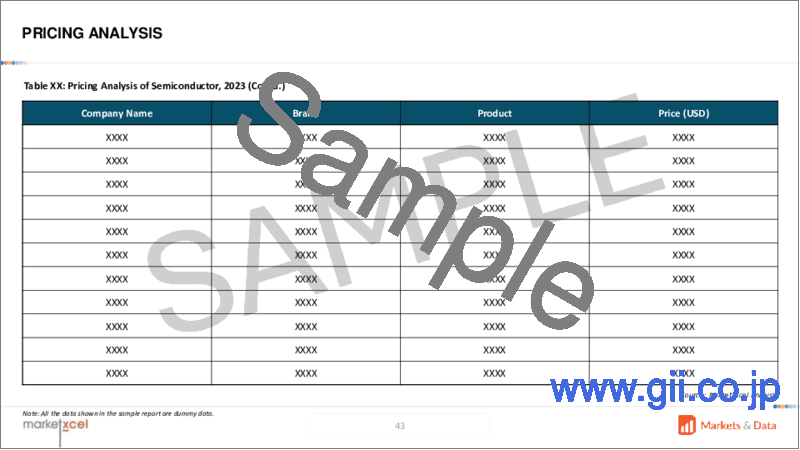|
|
市場調査レポート
商品コード
1556025
米国の半導体市場:タイプ別、コンポーネント別、ノードサイズ別、エンドユーザー別、地域別、機会、予測、2017年~2031年United States Semiconductor Market Assessment, By Type, By Components, By Node Size, By End-user, By Region, Opportunities and Forecast, 2017-2031F |
||||||
カスタマイズ可能
|
|||||||
| 米国の半導体市場:タイプ別、コンポーネント別、ノードサイズ別、エンドユーザー別、地域別、機会、予測、2017年~2031年 |
|
出版日: 2024年09月17日
発行: Markets & Data
ページ情報: 英文 128 Pages
納期: 3~5営業日
|
全表示
- 概要
- 図表
- 目次
米国の半導体の市場規模は、予測期間の2024年~2031年に7.04%のCAGRで拡大し、2023年の2,943億2,000万米ドルから2031年には5,072億1,000万米ドルに成長すると予測されています。米国では、AI、IoT、5G技術の出現により、半導体需要が急激に増加しています。さらに、米国政府は半導体のアップグレードに強く注目しており、その売上高は増加し、予測される数年間で市場の強力なプレゼンスを確立すると予想されます。米国半導体工業会(SIA)によると、2024年4月の世界の半導体の市場規模は464億米ドルで、2023年4月の合計401億米ドルから15.8%、2024年3月の合計459億米ドルから1.1%増加しました。企業収益に関しては、SIAは米国以外のチップ企業の約2/3、米国の半導体市場の99%を占めています。
米国政府は半導体製造施設に多額の投資を行っています。これらの施設は、スマートフォンから医療機器まで、幅広い機器に電力を供給する可能性を持つ重要な部品の製造を可能にします。
米国の半導体市場では、スマートフォンやモノのインターネット(IoT)ガジェットなど、アナログ集積回路(IC)に信号処理やオーディオ増幅などのタスクを依存する民生用電子機器の需要が高まっているため、アナログICの利用が増加しています。市場の成長を後押ししているのは、車載用電子機器におけるアナログICの使用の増加です。米国のアナログIC産業は、米国の半導体企業が技術のブレークスルーを推し進めるためにR&Dに投資することで、さらに活性化しています。
当レポートでは、米国の半導体市場について調査し、市場の概要とともに、タイプ別、コンポーネント別、ノードサイズ別、エンドユーザー別、地域別動向、および市場に参入する企業のプロファイルなどを提供しています。
目次
第1章 プロジェクトの範囲と定義
第2章 調査手法
第3章 エグゼクティブサマリー
第4章 顧客の声
第5章 米国の半導体市場の見通し、2017年~2031年
- 市場規模の分析と予測
- 市場シェア分析と予測
- 市場マップ分析、2023年
- タイプ別
- コンポーネント別
- ノードサイズ別
- エンドユーザー別
- 地域別
第6章 ポーターのファイブフォース分析
第7章 PESTLE分析
第8章 価格分析
第9章 市場力学
第10章 市場の動向と発展
第11章 ケーススタディ
第12章 競合情勢
- 市場リーダートップ5の競合マトリックス
- 参入企業トップ5のSWOT分析
- 市場の主要参入企業トップ10の情勢
- Intel Corporation
- Nvidia Corporation
- Texas Instruments Incorporated
- Qualcomm Inc.
- Micron Technology, Inc.
- Applied Materials, Inc
- GlobalFoundries Inc.
- Broadcom Inc.
- Texas Instruments Incorporated
- Advanced Micro Devices (AMD) Inc.
第13章 戦略的提言
第14章 お問い合わせと免責事項
List of Tables
- Table 1. Pricing Analysis of Products from Key Players
- Table 2. Competition Matrix of Top 5 Market Leaders
- Table 3. Mergers & Acquisitions/ Joint Ventures (If Applicable)
- Table 4. About Us - Regions and Countries Where We Have Executed Client Projects
List of Figures
- Figure 1. United States Semiconductor Market, By Value, In USD Billion, 2017-2031F
- Figure 2. United States Semiconductor Market, By Volume, In Units, 2017-2031F
- Figure 3. United States Semiconductor Market Share (%), By Type, 2017-2031F
- Figure 4. United States Semiconductor Market Share (%), By Components, 2017-2031F
- Figure 5. United States Semiconductor Market Share (%), By Node Size, 2017-2031F
- Figure 6. United States Semiconductor Market Share (%), By End-user, 2017-2031F
- Figure 7. United States Semiconductor Market Share (%), By Region, 2017-2031F
- Figure 8. By Type Map-Market Size (USD Billion) & Growth Rate (%), 2023
- Figure 9. By Components Map-Market Size (USD Billion) & Growth Rate (%), 2023
- Figure 10. By Node Size Map-Market Size (USD Billion) & Growth Rate (%), 2023
- Figure 11. By End-user Map-Market Size (USD Billion) & Growth Rate (%), 2023
- Figure 12. By Region Map-Market Size (USD Billion) & Growth Rate (%), 2023
United States semiconductor market is projected to witness a CAGR of 7.04% during the forecast period 2024-2031, growing from USD 294.32 billion in 2023 to USD 507.21 billion in 2031. The demand for semiconductors is increasing abruptly in the United States due to the advent of AI, IoT, and 5G technologies. Moreover, the United States government is focusing strongly on the upgradations of semiconductors, and its increase in sales and is anticipated to establish a strong presence of the market over the forecast years. As per the Semiconductor Industry Association (SIA) of the United States, in April 2024, the global semiconductor market sales saw USD 46.4 billion, with an increase of 15.8% from April 2023's total of USD 40.1 billion and 1.1% from March 2024's total of USD 45.9 billion. With respect to revenue, SIA accounts for approximately two-third of non-US chip companies and 99% of the United States semiconductor market.
Rise in Investments by the Government Towards Semiconductor Production Facilities
The United States government is investing a significant amount of money in semiconductor production facilities. These facilities enable the manufacturing of crucial components that have the potential to power a wide range of devices, from smartphones to medical equipment.
For instance, in April 2024, The CHIPS and Science Act rewarded Samsung Electronics up to USD 6.4 billion in cash, which would allow the company to significantly expand its semiconductor production facilities in Taylor, Texas. Along with growing its current Austin factory, the investment will allow Samsung to construct two new logic fabs, an R&D center, and an advanced packaging facility. More than 21,500 jobs are anticipated to be created by this initiative, which will establish the area as a significant hub for semiconductor production. This amount will support the stability of the American semiconductor supply chain while assisting Samsung in meeting the rising demand for sophisticated processors, particularly in high-demand fields such as artificial intelligence. This partnership between Samsung and the United States government highlights how crucial local chip manufacturing leads to the rise in country's economy and security.
Increase in Utilization of Analog ICs is Proliferating the Market Growth
The United States semiconductor market is using more analog ICs due to the rising demand for consumer electronics, such as smartphones and Internet of Things (IoT) gadgets, which depend on analog integrated circuits (ICs) for tasks including signal processing and audio amplification. The market growth is being fueled by the increasing use of analog ICs in automotive electronics. The analog IC industry in the United States is being further boosted by the investments made in R&D to push breakthroughs in technology by American semiconductor businesses.
For instance, in October 2023, the Center for design of analog-digital ICs (CDADIC) based in Washington DC, announced that its current projects include a broad spectrum of RF IC and analog/mixed-signal design domains. Micro-power CMOS interface circuits, high-performance CMOS mixed-signal circuits, data encoding methods for wireline links, phase noise suppression for multi-band receivers, interferer-tolerant wireless transceivers, and PVT-invariant low-power clock generation for 5G and beyond are some of the notable projects. Teams of researchers, students, and professionals from the industry are actively working together on these projects to tackle the notable problems and contribute to the advancement in the field of analog/RF IC design of the country.
Robust Technological Advancements are Expediting the Semiconductor Market
A continuous surge in technological upgradations is accelerating the United States market growth. Upgraded semiconductor packaging is currently the key trend in the market and is expected to gain traction in the coming years. For instance, in July 2024, through the CHIPS for America initiative, the Biden-Harris administration intended to invest up to USD 1.6 billion to build and accelerate American capacity for semiconductor advanced packaging. The research and development efforts in five main areas, such as new package structures, materials, and processes, will be aided by this financing. The objective is to push the boundaries of new packaging technologies and establish a thriving local semiconductor ecosystem with a variety of sophisticated semiconductor packaging solutions. The United States will become a leader in advanced semiconductor manufacturing due to this investment, which is essential to enabling innovative applications such as artificial intelligence and high-performance computing. Moreover, the funds will be used to supplement industrial and academic private sector investments.
Government Initiatives Acting as a Catalyst
The United States government is focusing on the manufacturing of semiconductor devices by launching stringent policies in the market. These policies are estimated to bring ample opportunities for market growth in the projected years. For instance, in March 2024, Under the International Technology Security & Innovation (ITSI) Fund, the U.S. Department of State announced intentions to collaborate with the Government of Mexico to investigate prospects for expanding and diversifying the global semiconductor supply chain. Through cooperative efforts, this partnership seeks to improve the security and resilience of the semiconductor supply chain.
Coordination of government incentive programs, establishment of international semiconductor supply chains, information sharing, and the implementation of security measures are some of the areas on which the collaboration will concentrate. The United States endeavors to decrease its dependence on foreign semiconductor suppliers and establish a more resilient and varied worldwide semiconductor network by collaborating closely with Mexico, will be a significant step towards the growth of the market.
Western United States to Dominate the Market Share
The western United States, especially Silicon Valley in California, dominates the semiconductor business due to its concentration of big corporations, innovation hubs, and trained labor. This region benefits from large investments, such as the CHIPS & Science Act, which aims to increase local manufacturing. The existence of leading semiconductor companies, research institutions, and a collaborative ecosystem promotes technical innovation and increases the region's global competitiveness in the market.
However, the United States produces around 12% of the total worldwide semiconductor output, and programs such as the CHIPS Act to boost America's local chip manufacturing capabilities.
Future Market Scenario (2024 - 2031F)
In the United States, the demand for discrete power devices is gaining traction for their efficiency in power electronics applications, which, in turn, is expected to lead to extensive opportunities in the future for market growth.
Demand from automotive, industrial, and consumer electronics industries is driving the use of analog ICs in the United States. This can lead to ample opportunities for market growth over the forecast years.
Furthermore, the continuous rise in investments towards research and development solutions is amplifying the market growth extensively and is estimated to lead to the advent of new technologies, such as semiconductors, in the country.
Key Players Landscape and Outlook
Semiconductors are of vital importance to the United States due to their modern electronics, with the entire market expected to hit USD 1 trillion by 2030. The presence of a robust domestic semiconductor sector could make America an economic tycoon to the rivals.
In March 2024, the United States government granted loans totaling around USD 20 billion to Intel Corporation for financing the growth of its semiconductor production facilities. More than USD 100 billion in Intel's U.S. projects will be financed by this investment, including state-wide research and development initiatives and state-of-the-art chip manufacturing in Arizona and Ohio. Secure supply chains and homegrown semiconductor manufacturers are the two main objectives of the investment.
Table of Contents
1. Project Scope and Definitions
2. Research Methodology
3. Executive Summary
4. Voice of Customer
- 4.1. Product and Market Intelligence
- 4.2. Brand Awareness
- 4.3. Factors Considered in Purchase Decisions
- 4.3.1. Quality
- 4.3.2. Price
- 4.3.3. Purpose
- 4.3.4. Order Quantity
- 4.3.5. Lifespan
- 4.3.6. Experience in the industry
- 4.4. Operational Cost
- 4.5. Supply Chain Management
- 4.6. Demand and Supply Mechanism
- 4.7. Channel of Purchase
5. United States Semiconductor Market Outlook, 2017-2031F
- 5.1. Market Size Analysis & Forecast
- 5.1.1. By Value
- 5.1.2. By Volume
- 5.2. Market Share Analysis & Forecast
- 5.2.1. By Type
- 5.2.1.1. Intrinsic
- 5.2.1.2. Extrinsic
- 5.2.2. By Components
- 5.2.2.1. Memory Devices
- 5.2.2.2. Logic Devices
- 5.2.2.3. Analog IC
- 5.2.2.4. MPU
- 5.2.2.5. Discrete Power Devices
- 5.2.2.6. MCU Sensors
- 5.2.2.7. Others
- 5.2.3. By Node Size
- 5.2.3.1. 180 nm
- 5.2.3.2. 130 nm
- 5.2.3.3. 90 nm
- 5.2.3.4. 65 nm
- 5.2.3.5. 45/40 nm
- 5.2.3.6. 32/28 nm
- 5.2.3.7. 22/20 nm
- 5.2.3.8. 16/14 nm
- 5.2.3.9. 10/7 nm
- 5.2.3.10. 7/5 nm
- 5.2.3.11. 5 nm
- 5.2.4. By End-user
- 5.2.4.1. Networking and Communications
- 5.2.4.2. Consumer Electronics
- 5.2.4.3. Automotive
- 5.2.4.4. Data Processing
- 5.2.4.5. Aerospace
- 5.2.4.6. Medical
- 5.2.4.7. Military and Defense
- 5.2.4.8. Others
- 5.2.5. By Region
- 5.2.5.1. Northeast
- 5.2.5.2. Southwest
- 5.2.5.3. West
- 5.2.5.4. Southeast
- 5.2.5.5. Midwest
- 5.2.6. By Company Market Share Analysis (Top 5 Companies and Others - By Value, 2023)
- 5.2.1. By Type
- 5.3. Market Map Analysis, 2023
- 5.3.1. By Type
- 5.3.2. By Components
- 5.3.3. By Node Size
- 5.3.4. By End-user
- 5.3.5. By Region
6. Porter's Five Forces Analysis
7. PESTLE Analysis
8. Pricing Analysis
9. Market Dynamics
- 9.1. Market Drivers
- 9.2. Market Challenges
10. Market Trends and Developments
11. Case Studies
12. Competitive Landscape
- 12.1. Competition Matrix of Top 5 Market Leaders
- 12.2. SWOT Analysis for Top 5 Players
- 12.3. Key Players Landscape for Top 10 Market Players
- 12.3.1. Intel Corporation
- 12.3.1.1. Company Details
- 12.3.1.2. Key Management Personnel
- 12.3.1.3. Products and Services
- 12.3.1.4. Financials (As Reported)
- 12.3.1.5. Key Market Focus and Geographical Presence
- 12.3.1.6. Recent Developments/Collaborations/Partnerships/Mergers and Acquisition
- 12.3.2. Nvidia Corporation
- 12.3.3. Texas Instruments Incorporated
- 12.3.4. Qualcomm Inc.
- 12.3.5. Micron Technology, Inc.
- 12.3.6. Applied Materials, Inc
- 12.3.7. GlobalFoundries Inc.
- 12.3.8. Broadcom Inc.
- 12.3.9. Texas Instruments Incorporated
- 12.3.10. Advanced Micro Devices (AMD) Inc.
- 12.3.1. Intel Corporation
Companies mentioned above DO NOT hold any order as per market share and can be changed as per information available during research work.






